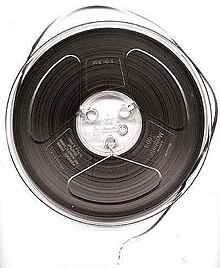Magnetic tape

Magnetic tape is a medium for magnetic storage made of a thin, magnetizable coating on a long, narrow strip of plastic film. It was developed in Germany in 1928, based on the earlier magnetic wire recording from Denmark. Devices that use magnetic tape could with relative ease record and playback audio, visual, and binary computer data.
Magnetic tape revolutionized sound recording and reproduction and broadcasting. It allowed radio, which had always been broadcast live, to be recorded for later or repeated airing. Since the early 1950s, magnetic tape has been used with computers to store large quantities of data and is still used for backup purposes.
Magnetic tape begins to degrade after 10–20 years and therefore is not an ideal medium for long-term archival storage.[1] The exception is data tape formats like LTO which are specifically designed for long-term archiving.[2]
Durability[edit]
While good for short-term use, magnetic tape is highly prone to disintegration. Depending on the environment, this process may begin after 10–20 years.[1]
Over time, magnetic tape made in the 1970s and 1980s can suffer from a type of deterioration called sticky-shed syndrome. It is caused by hydrolysis of the binder in the tape and can render the tape unusable.[3]
Successors[edit]
Since the introduction of magnetic tape, other technologies have been developed that can perform the same functions, and therefore, replace it. Despite this, technological innovation continues. As of 2014[update] Sony and IBM continue to advance tape capacity.[4]
Uses[edit]
Audio[edit]

Magnetic tape was invented for recording sound by Fritz Pfleumer in 1928 in Germany.[5]
Because of escalating political tensions and the outbreak of World War II, these developments in Germany were largely kept secret. Although the Allies knew from their monitoring of Nazi radio broadcasts that the Germans had some new form of recording technology, its nature was not discovered until the Allies acquired German recording equipment as they invaded Europe at the end of the war.[6] It was only after the war that Americans, particularly Jack Mullin, John Herbert Orr, and Richard H. Ranger, were able to bring this technology out of Germany and develop it into commercially viable formats. Bing Crosby, an early adopter of the technology, made a large investment in the tape hardware manufacturer Ampex.[7]
A wide variety of audiotape recorders and formats have been developed since. Some magnetic tape-based formats include:
- Reel-to-reel
- Fidelipac
- Stereo-Pak (Muntz Stereo-Pak, commonly known as the 4-track cartridge)
- Perforated (sprocketed) film audio magnetic tape (sepmag, perfotape, sound follower tape, magnetic film)
- 8-track tape
- Compact Cassette
- Elcaset
- RCA tape cartridge
- Mini-Cassette
- Microcassette
- Picocassette
- NT (cassette)
- ProDigi
- Digital Audio Stationary Head
- Digital Audio Tape
- Digital Compact Cassette
Video[edit]

Some magnetic tape-based formats include:
- Quadruplex videotape
- Ampex 2 inch helical VTR
- Type A videotape
- IVC videotape format
- Type B videotape
- Type C videotape
- EIAJ-1
- U-matic
- Video Cassette Recording
- Cartrivision
- VHS
- Video 2000
- V-Cord
- VX (videocassette format)
- Betamax
- Compact Video Cassette
- Betacam
- M (videocassette format)
- MII (videocassette format)
- D-1 (Sony)
- DCT (videocassette format)
- D-2 (video)
- D-3 (video)
- D5 HD
- D6 HDTV VTR
- Video8
- Hi8
- Digital8
- DV
- MicroMV
Computer data[edit]

| Computer memory and Computer data storage types |
|---|
| Volatile |
| Non-volatile |
Magnetic-tape data storage is a system for storing digital information on magnetic tape using digital recording.
Tape was an important medium for primary data storage in early computers, typically using large open reels of 7-track, later 9-track tape. Modern magnetic tape is most commonly packaged in cartridges and cassettes, such as the widely supported Linear Tape-Open (LTO)[8] and IBM 3592 series. The device that performs the writing or reading of data is called a tape drive. Autoloaders and tape libraries are often used to automate cartridge handling and exchange. Compatibility was important to enable transferring data.
Tape data storage[9] is now used more for system backup,[10] data archive and data exchange. The low cost of tape has kept it viable for long-term storage and archive.[11]See also[edit]
- Analog recording
- Magnetic developer
- Print-through – Transfer of content between magnetic tape layers
Notes[edit]
References[edit]
- ^ a b Pogue, David (1 September 2016). "Digitize Those Memory-Filled Cassettes before They Disintegrate". Scientific American. Archived from the original on 19 August 2016. Retrieved 26 July 2022.
- ^ Coughlin, Tom. "LTO Tape Capacity Shipments Up In 2022". Forbes. Retrieved 19 December 2023.
- ^ "Magnetic Materials" (PDF). Memory of the World: Safeguarding the Documentary Heritage. A guide to Standards, Recommended Practices and Reference Literature Related to the Preservation of Documents of All Kinds. UNESCO. 1998. CII.98/WS/4. Retrieved 12 December 2017.
- ^ "Sony develops magnetic-tape technology with the world's highest*1 areal recording density of 148 Gb/in2". Sony Global. Archived from the original on 5 May 2014. Retrieved 4 May 2014.
- ^ Eric D. Daniel; C. Denis Mee; Mark H. Clark (1998). Magnetic Recording: The First 100 Years. Wiley-IEEE. ISBN 0-7803-4709-9.
- ^ "BBC World Service - The Documentary Podcast, A History of Music and Technology: Sound Recording". BBC. 18 June 2019. Archived from the original on 1 July 2019. Retrieved 1 July 2019.
- ^ Fenster, J.M. (Fall 1994). "How Bing Crosby Brought You Audiotape". Invention & Technology. Archived from the original on 4 April 2011.
- ^ "LTO Compliance-Verified Licencees". Ultrium. Archived from the original on 13 November 2006. Retrieved 29 March 2013.
- ^ M. K. Roy; Debabrata Ghosh Dastidar (1989). Cobol Programming. p. 18. ISBN 0074603183.
- ^ "Ten Reasons Why Tape Is Still The Best Way To Backup Data".
- ^ Coughlin, Tom. "The Costs Of Storage". Forbes. Retrieved 3 November 2020.
